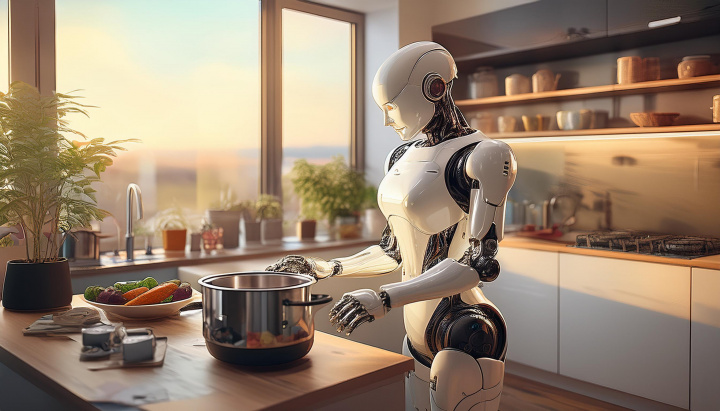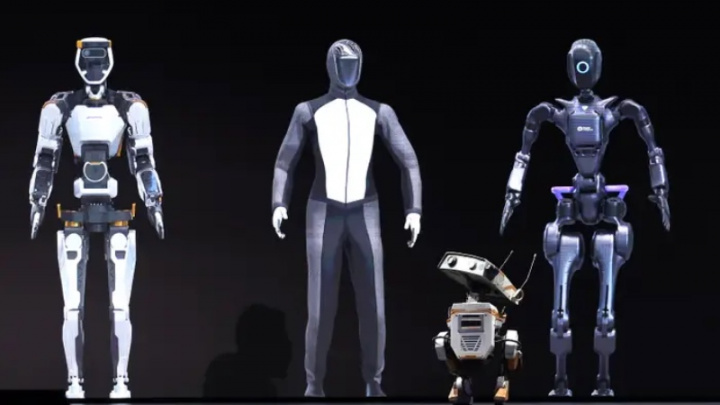Robots That Learn on the Job: The Rise of Self-Training AI
Imagine robots that don't just follow pre-programmed instructions but actually learn and adapt while performing tasks in our unpredictable world. Researchers at MIT have recently developed a novel algorithm called "Estimate, Extrapolate, and Situate" (EES), marking a significant step in this direction. This innovation promises to enhance robotics by enabling machines to train themselves effectively, reducing the need for constant human intervention and potentially revolutionizing their capabilities across numerous domains.

The Challenge: Bridging the Gap Between Code and Reality
Traditionally, programming robots for complex, real-world tasks has been laborious. Robots often operate based on rigid code or models trained extensively in simulations. However, the real world is messy and unpredictable. A pre-programmed robot might fail if an object isn't exactly where expected, or if an unforeseen obstacle appears. While methods like reinforcement learning (RL) allow robots to learn through trial-and-error, doing this directly in the physical world can be slow, unsafe, and data-intensive. Training purely in simulation often suffers from the "sim-to-real" gap, where strategies learned in virtual environments don't transfer perfectly to physical reality. This is where algorithms like EES come into play, aiming to give robots more robust, adaptive learning capabilities directly within their working environment.
EES Explained: Estimate, Extrapolate, Situate
The EES algorithm integrates the strengths of Large Language Models (LLMs) – known for their text-based reasoning and vast world knowledge – with real-time robot motion data. This fusion allows household robots, for example, to adapt more effectively to new tasks and environments. But how does it work? Let's break down the name:
- Estimate: The robot constantly assesses its current physical state and its relationship to the ongoing task. For instance, if tasked with clearing a table, it estimates "I am holding a cup" or "My hand is empty and near the table."
- Extrapolate: Using its understanding of the task (often derived from LLM-based planning) and its current state, the robot predicts potential next steps and their outcomes. "If I move forward, I can place the cup in the sink," or "If I encounter an obstacle, I need to find an alternative path."
- Situate: This crucial step involves the robot contextualizing its current state and actions within the broader goal of the task. It links its physical state ("holding cup") to a natural language label or sub-goal provided by the LLM ("transporting cup to sink"). If interrupted (e.g., needing to put the cup down temporarily to open a door), the robot understands it hasn't failed the overall task but merely paused a sub-task. It can then resume logically, knowing *why* it paused and what the next step towards the ultimate goal ("clear the table") should be.
This cycle allows robots to break down complex chores into logical sub-tasks. Crucially, if interrupted or facing an unexpected situation, they don't necessarily need to restart the entire process. Instead, they can re-estimate, re-extrapolate, and re-situate themselves within the task flow, significantly boosting efficiency and resilience, especially for complex household duties.
The Power of LLMs: Injecting "Common Sense" into Motion
Large Language Models play a pivotal role in enhancing the capabilities of these self-training robots. It's not just about understanding language commands; LLMs provide a form of "common sense" reasoning. By connecting the robot's motion data and sensor readings with the LLM's knowledge base, the system enables robots to:
- Logically decompose tasks: An LLM can break down a high-level command like "clean the kitchen counter" into a sequence of actionable steps (e.g., identify clutter, pick up items, wipe surface).
- Reason about objects and environments: The LLM understands that a glass is fragile, a sponge is for wiping, and putting electronics in the sink is a bad idea.
- Handle ambiguity and interruptions gracefully: If a robot encounters an unknown object while cleaning, the LLM can help infer its likely properties or suggest asking a human. If a sub-task fails, the LLM helps the robot understand the context and attempt corrective actions relevant to the overall goal.
This integration automates identifying and sequencing sub-tasks, simplifying the process of teaching complex behaviors. It moves beyond simple pattern matching in motion data, adding a layer of semantic understanding that makes the robot's behavior more flexible and adaptive, paving the way for more versatile and intelligent household robots requiring minimal human guidance.
Self-Training and Adaptation in Action
The EES algorithm empowers robots to autonomously refine their skills and continuously improve performance. By constantly estimating, extrapolating, and situating, they build a better understanding of how their actions affect the environment. This allows them to make more informed decisions over time. This capability is particularly valuable for household robots encountering unfamiliar objects or layouts in users' homes. With EES, a robot tasked with setting the table in a new house could adapt its grasping strategy for unfamiliar plates or navigate around unexpected furniture, modifying its behavior to successfully complete tasks even in previously unseen environments.
Broader Implications for the Robotics Industry
Self-training algorithms like EES have far-reaching consequences. By enabling robots to adapt to new environments and tasks without extensive reprogramming, this technology can significantly reduce deployment costs and increase the versatility of robotic systems across various sectors. Healthcare could benefit from assistants adapting to patient needs in homes, manufacturing from robots quickly learning new assembly variations, and logistics from machines handling diverse and unexpected packages or warehouse layouts. Furthermore, this fusion of AI and robotics could accelerate the development of truly helpful home assistant robots, potentially revolutionizing elder care and rehabilitation services by providing adaptable, multi-functional support within domestic settings.
Challenges and the Road Ahead
While promising, challenges remain. Ensuring safety, especially as robots learn autonomously in human environments, is paramount. Bridging the subtle differences between simulation and reality (the sim-to-real gap) continues to be an area of active research. The computational resources required for running sophisticated models like LLMs onboard robots and the need for diverse real-world training data also present hurdles. However, the progress is undeniable.
Conclusion:
Overall, the EES algorithm and similar approaches represent a new frontier in robotics. By enabling robots to learn and adapt on the job, leveraging the reasoning power of LLMs, we are moving closer to creating machines that are not just tools, but truly intelligent partners. This advancement holds the potential to significantly impact not only household robotics but also a wide array of industries in the near future, making robots more capable, versatile, and integrated into our lives.





